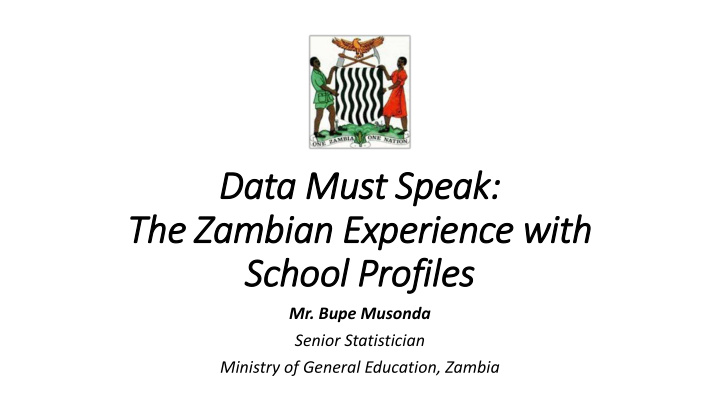



Data Must Speak: The Zambian Experience wit ith School Profiles Mr. Bupe Musonda Senior Statistician Ministry of General Education, Zambia
Zambia - context xt • Sub-Saharan African country • 4,000,000 students • Largely achieved MDG2 around primary school enrolment • Over 8,800 primary schools, around 850 secondary schools • Two ministries in charge of Education – General and Higher • Education Management Information System (EMIS) within MoGE Directorate of Planning • Comprehensive database • Data collected annually from schools
Background and rationale for the profiles • Prior to the Data Must Speak initiative the Directorate used to produce profiles as a feedback mechanism but process was discontinued in 2005, original profiles were completely text based and provided no examination or comparative data Ministry of General Education had identified the need to: • Promote and improve the usage of data at all levels of education • Improve evidence-based decision-making, planning & priority setting • Improve data feedback loops (at School, Community, District & Province levels) • Enhance community engagement in school management and decision- making
Successes to date • In 2015 the Ministry in collaboration with UNICEF embarked on the Data Must Speak Initiative • In 2015 school profiles were designed collaboratively with teachers, PTA members, district, provincial, central level Ministry staff • In 2016 school profiles were printed and distributed to over 8,900 schools • In 2016-17, province, district and community (simplified) level profiles were developed and produced in addition to updated school profiles
School Profile • Two page document, A3 in color • Provides schools with key selected indicators • Provides feedback from the Annual School Census • Allows SELF-monitoring for schools • Allows school management to identify need and priority areas • Assists schools in the development of School Improvement Plans (SIPs) Front page ->
Community Profile • One page document, A4, multiple copies • Provides school communities with simplified information • Provides feedback from the Annual School Census and school examinations • Allows SELF-monitoring for schools • Allows low-literacy communities to understand their school in comparison to district averages and over time
Pro rovincial and District Pro rofiles • Same idea as with the school and community profiles • Contain selected key Provincial and District Indicators • At a glance one can have a picture on how the province or District is performing in education delivery • Shows how well resourced a province or district is e.g. PTR can guide in the allocation and distribution of teachers • Education staff in 3 out of 10 provinces trained in the interpretation and usage of profile, remaining planned for Q3 2017. Extracts from a district profile
Challenges • Profile printing is expensive • Distribution to all schools is logistically difficult • Delayed printing and distribution – data reliability and usability is reduced • Matching of ECZ and EMIS – not all schools have examination results • Limited understanding of how the profiles are being used at school level
Next xt steps and fu future plans • Alignment of ECZ and EMIS codes to improve school matching • Follow-up studies on comprehension and use of profiles • Community training on profile usage • Impact evaluation of the DMS community profiles • Development of profiles for secondary schools • Further training and capacity-building at all levels
Thank you! Photo credit: UNICEF 2015/L Jonsson
Recommend
More recommend